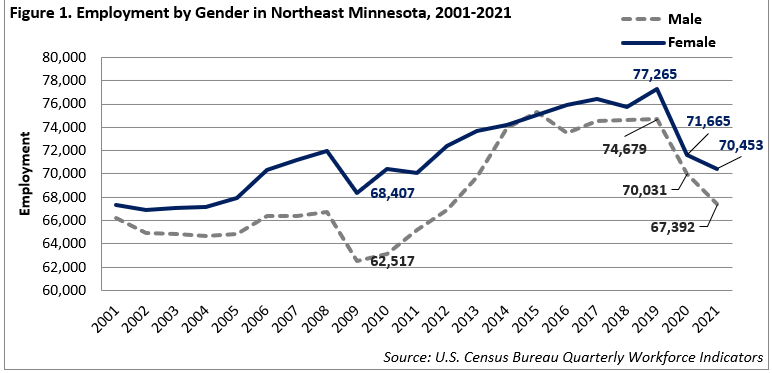 Home to the state's second-largest metro, the Northeast Region has a strong industrial sector, tied largely to the area's abundant natural resources.
Home to the state's second-largest metro, the Northeast Region has a strong industrial sector, tied largely to the area's abundant natural resources.
Most of the manufacturing base centers on mining and forest products industries. More than half of the sector's employment is in paper and machinery manufacturing.
Want the freshest data delivered by email? Subscribe to our regional newsletters.
3/11/2022 9:00:00 AM
Carson Gorecki
Women hold about half the jobs in Northeast Minnesota. Some sectors, such as Health Care & Social Assistance, Finance & Insurance, and Educational Services have high shares of female employment. Each of the six sectors that employ more women than men are service-oriented, whereas goods-producing sectors such as Mining, Construction, and Transportation & Warehousing have much lower shares of female workers. Indeed, in those three male-dominated sectors, fewer than one out of every five employees were women. Conversely, in Health Care & Social Assistance more than three out of every four workers were women (see Table 1). These observations raise the questions: How long have these patterns of female employment concentration been this way? And how are they changing?
Table 1. Female Employment Share by Sector in Northeast Minnesota
| Sector | Female Employment Share, 2021* | Percent Change in Female Employment Share,
2016-2021 |
|---|---|---|
| Total, All Industries | 50.2% | -0.8% |
| Health Care and Social Assistance | 78.5% | +0.9% |
| Finance and Insurance | 68.8% | -0.3% |
| Educational Services | 66.7% | +1.0% |
| Accommodation and Food Services | 57.5% | +1.2% |
| Management of Companies | 56.2% | -6.3% |
| Other Services | 56.1% | +7.2% |
| Retail Trade | 48.3% | -1.5% |
| Professional and Technical Services | 48.2% | -2.8% |
| Real Estate and Rental and Leasing | 46.3% | +0.2% |
| Arts, Entertainment, and Recreation | 46.1% | -2.9% |
| Public Administration | 43.2% | +1.3% |
| Information | 39.6% | -5.6% |
| Administrative Support and Waste Services | 35.8% | -13.9% |
| Utilities | 26.7% | +9.9% |
| Agriculture, Forestry, Fishing & Hunting | 24.7% | +24.1% |
| Wholesale Trade | 21.4% | +3.1% |
| Manufacturing | 21.2% | -0.9% |
| Transportation and Warehousing | 19.3% | -1.3% |
| Construction | 11.6% | +16.0% |
| Mining | 7.2% | -4.7% |
| *1st and 2nd Quarter. Source: DEED Quarterly Employment Demographics | ||
Before this analysis, if you would have asked me which sectors have seen the largest relative growth in female employment over the past several years, my educated guesses would have been the sectors that started with the lowest shares. Typically goods-producing, these sectors had the most room for growth of their respective female workforces. To that end, the data show that some of the largest relative growth occurred in the Agriculture, Forestry, Fishing, & Hunting sector, which saw its share of workers who are women grow from 19.9% to 24.7% over the last five years. Construction, another traditionally male-dominated, goods-producing sector, saw the next largest relative increase, seeing its share of female workers grow 16%. However, Mining, Transportation & Warehousing, and Manufacturing – three of the four sectors with the lowest shares of women workers – each saw their respective female workforces shrink at above average rates since 2016. By contrast, Health Care & Social Assistance, which has the largest female workforce, both relatively and absolutely, saw a small relative expansion in the share of female workers over the past five years, despite losing 617 women workers.
Most of the employment declines for women since 2016 occurred in 2020, with the onset of the coronavirus pandemic. While total employment for women declined by about 5,500 jobs over the last five years, 5,600 jobs held by women were lost just between 2019 and 2020. Prior to the pandemic, jobs held by women grew 15% from 2004 to 2019, about the same rate as male employment over the same period. Due to higher concentrations in Manufacturing and Construction, male employment took a harder hit during the Great Recession from 2008 through 2010, but also grew faster in the years following. In the years immediately preceding the pandemic however, female employment grew faster in the region while male employment plateaued between 2014 and 2019 (see Figure 1).

Much attention has been focused on women being more likely to exit the labor force during the past two years, due to many reasons including lack of child care, other caretaking responsibilities that tend to fall on women, and in many instances, burnout. Despite these factors, data show that female employment (-8.8%) declined less from 2019 to 2021 than male employment (-9.8%) in the region. This does not necessarily contradict the labor force data, which are available by gender only at the state level.
Women workers in Northeast Minnesota could indeed have weathered the pandemic relatively better than those in other regions. Another possible explanation is that more women among the ranks of the unemployed left the labor force over the course of the pandemic, as opposed to those that held jobs. Whatever the explanation(s), it remains true that women are vital to our economy. In this extremely tight labor market where competition for workers is fierce, all employers serve to benefit by making their workplaces more welcoming and appealing to 50% of the labor force.
Contact Northeast Minnesota Labor Market Analyst Carson Gorecki at 218-302-8413.